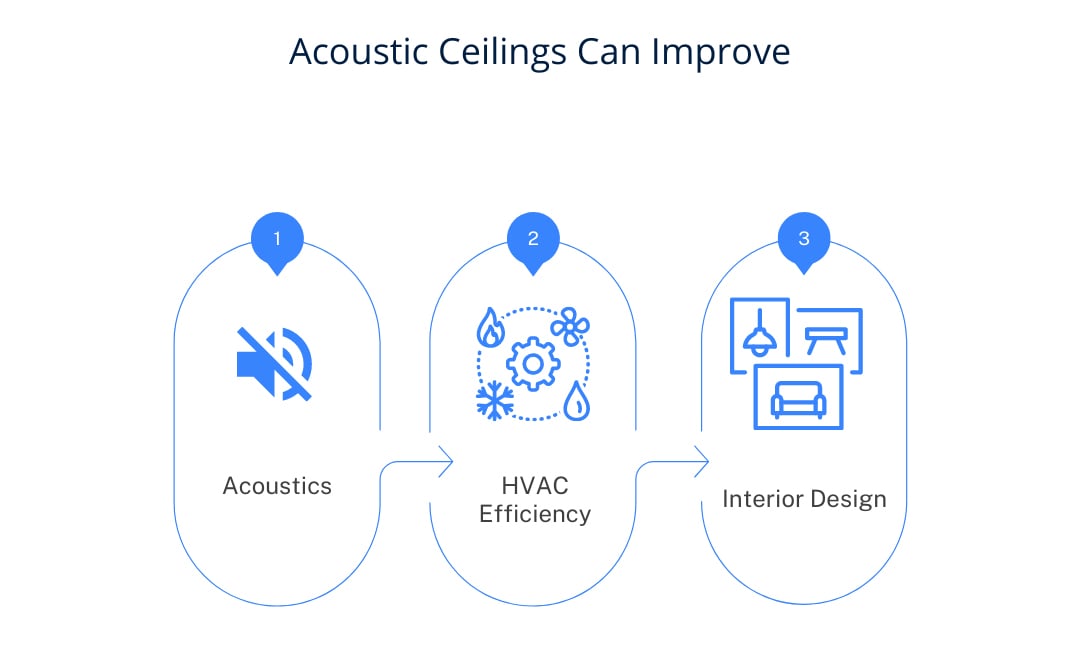What Are Acoustic Ceiling Tiles? A Guide to Suspended Ceiling Tile Panels
Overview
From sound-management to energy efficiency, acoustic ceiling tiles can offer a whole host of benefits – often at a relatively small price tag. But what are acoustic ceiling tiles? How much do they cost? And how do you cut and install them? You’ll discover all this and more in our complete guide to suspended acoustic ceiling tiles and panels.
What’s An Acoustic Ceiling?
A suspended acoustic ceiling – sometimes also known as a ‘dropped ceiling’ – is a secondary ceiling suspended beneath the main (structural) ceiling of a building. They’re not only an aesthetically pleasing alternative to leaving your structural ceiling bare, they can also serve a number of functions as well.
What Are Acoustic Ceiling Tiles?
Acoustic ceiling tiles are a type of covering that you can add to your ceiling to improve the acoustics of the room. They can be made from a variety of materials, and may even feature perforations or unique textures to help manage the way sound behaves in a space.
Why Use Acoustic Ceiling Tiles?
Installing acoustic ceiling tiles in a suspended ceiling can minimise noise and reverberation, and may even be an effective option for sound proofing your building. But acoustic control isn’t the only benefit. In fact, your suspended ceiling can be designed in a way that helps your space not only control noise levels, but also:
Improve HVAC efficiency by keep warm or cool air in
Manage noise and temperature for a more comfortable work environment
Conceal unsightly wires, pipes, insulation, and ductwork in the roof
Serve as a decorative element that enhances the look of your building
Suspended tiles are designed to rest in a building’s existing ceiling grid system. This eliminates the need for expensive – and extensive – construction work and installation, representing a significant saving in time and money for buildings that already have a grid system.
Acoustic Ceilings Can Improve Acoustics, HVAC Efficiency, and Interior Design

Do Suspended Ceiling Solutions Really Work to Improve Acoustics?
The short answer? Yes! Acoustic ceiling tiles really do work. In fact, along with acoustic wall panels, they’re one of the most effective ways of managing noise in a building. But how do they work?
Sound absorbing drop ceiling tiles provide effective noise controlling properties. As the ceiling tends to be closer to our ears than other surfaces, covering it with sound absorbing materials is one of the easiest ways to minimise echoing and improve sound quality without compromising the ‘look’ or functionality of the space.
Depending on their design, there are three primary acoustic purposes for which suspended acoustic ceiling tiles are used:
Sound dampening: Softer materials can physically ‘absorb’ sound waves to minimise reverberation. This makes for a more pleasant environment that reduces annoyance, improves focus, and boosts productivity in the workplace.
Sound diffusion: This is the process of disseminating the number of sound waves that are reflected in any single direction. Some tiles come with unique textures to help scatter the energy, causing sound to disperse evenly throughout the room.
Soundproofing: By acting as a barrier to sound, your tiles can help prevent external noises from coming into a room, while also inhibiting internal noise from transmitting outwards. This can improve both comfort and privacy.
Minimise Noise Distraction and Improve Sound Quality

Acoustic Ceiling Materials: What Are Acoustic Ceilings Made Of?
So what are acoustic tiles made of? Ceiling tiles come in a wide range of materials, so choosing the right one for you will depend on your needs, goals, and budget.
Fibreglass Ceiling Tiles
Typically made from glass fibres encased in polymers, fibreglass ceiling tiles are relatively low-cost, and effective at absorbing sound. They’re also fairly sturdy, resilient to ageing and sagging, and are generally non-combustible, making them a safer option for both commercial and residential use.
Fibreglass vs Mineral Fibre Ceiling Tiles
Due to its high affordability, mineral fibre is one of the most popular materials used in acoustic tiles today. However, mineral fibre isn’t particularly robust, meaning it will likely need to be replaced more regularly than other products on the market.
Mineral fibre is also a lot more prone to water damage than fibreglass, which is typically water-resistant. This makes fibreglass tiles a better option for moist or humid environments. It’s important to note that both fibreglass and mineral fibre can suffer damage when wet, so you’re best to consider a different material in excessively damp environments.
Plasterboard Tiles
Some types of plasterboard are specifically designed with a higher density core to make it more resistant to the transference of sound. As sound passes through the denser material, it will dissipate more quickly, meaning less noise can travel to other rooms.
Wood Ceiling Panels
An attractive solution that offers some noise reduction, there are plenty of low-cost wood panels available for smaller budgets. When it comes to dampening sound, wood isn’t typically as effective as softer materials. It can also be vulnerable to damage in humid or moist environments.
Metal Ceiling Sheets
Made from thin sheets of metal and often featuring an acoustic pad for additional soundproofing, metal acoustic tiles offer superior noise reduction and are effective at improving the acoustics of a room. However, their high cost may make them impractical for those on a small budget.
Melamine Tiles
Melamine offers outstanding acoustic performance and is highly effective at controlling noise in busy commercial buildings. However, melamine comes with a hefty price tag that many businesses might find prohibitive.
Polyester Fibre (PET)
Lightweight, cost-effective, and delivering excellent acoustic performance, PET acoustic ceiling tiles have the power to absorb sound, meaning they offer outstanding noise dampening properties. They’re also highly durable, fire-resistant, mould-proof, moisture-proof, and environmentally friendly, making them a fabulous alternative to mineral fibre or fibreglass tiles.
PET Tiles Offer Excellent Acoustic Performance at a Low Price Point

Decorative Ceiling Tiles
Acoustic ceiling tiles can be more than just functional, they can look good too! In fact, with the right planning – and proper consideration of your interior design – your ceiling tiles can really enhance the look of your space.
If you’ve chosen to pursue a natural style that incorporates a lot of wooden elements, for example, wood ceiling tiles could be the perfect choice. On the other hand, a minimalist room design might be more suited to the simple, clean look of PET, melamine, metal, or acoustic plasterboard. Metal can also be an appropriate option for an industrial chic style – a style that utilises a lot of raw materials, such as metal, concrete, and even wood.
Some acoustic ceiling tiles also come in a variety of gorgeous colours which can be arranged into a stylish pattern to really enhance the look of your space
Acoustic Panels Can be a Striking Design Element

Acoustic Ceiling Tile Installation
So how do you install acoustic ceiling tiles? The good news is it’s incredibly easy!
Installing acoustic ceiling tiles into an existing grid is as simple as measuring the spaces within your grid and purchasing the tiles to match – or cutting them down to the right size. From there, all you need to do is push the old ceiling tile up and out of the grid. You can then gently slide your new acoustic ceiling tile up through the newly opened gap before gently dropping it into position. With no need for adhesive, joint, or screw support, replacing your ceiling tiles is a breeze!
If your building doesn’t have a dropped ceiling, you’ll first need to find a builder to install your grid.
Replacing Tiles is a Simple Process

How to Cut Acoustic Ceiling Tiles
Some types of ceiling panels can easily be cut with little more than a carpet knife. If you need to customise your ceiling tiles to fit your grid, here’s what you need to do:
Step 1: To cut each acoustic tile accurately, start by measuring your grid from the wall to the edge of the first cross T.
Step 2: Use the hook of your tape measure to accurately score a cut line along the tile. If the line is less than halfway in, you can score the other side too to get two panels from the one piece.
Step 3: Cut along the line you just marked with your carpet knife, making steadily deeper cuts until you’ve cut the whole way through.
Step 4: So that your tile lies flat in the grid, you’ll need to cut a ‘shadow line’. Do this by placing the tile into the grid and marking along where the metal support touches the tile.
Step 5: Take the tile back down and follow along the new line, cutting about halfway through the tile.
Step 6: Lay the knife on its side and cut through the edge of the tile until you’ve cut away a strip of material.
Step 7: Place the acoustic tile back into the ceiling grid. If you’ve measured and cut correctly, it should now fit snuggly.
Step 8: Continue cutting the remainder of your ceiling tiles in the same fashion until complete.
Pre-Sized Solutions
Cutting your own panels for an acoustic ceiling can be difficult work, and not all ceiling tiles can easily be cut. Thankfully, there are many pre-sized solutions available to fit acoustic ceilings of any shape or size.
Our PET ceiling tiles, for example, come in 595 x 595mm, and 1195 x 595mm panels, saving you time and effort on cutting your own.
Acoustic Ceiling Tiles: Price
So how much are acoustic ceiling tiles? The cost of acoustic ceiling tiles will depend a great deal on the material they’re made from and the size of the panels. Fibreglass, mineral fibre, and PET panels typically represent the most budget-friendly options, while metal, melamine, and other specialty surfaces tend to sit at a higher price point.
Our acoustic panels, for example, offer outstanding acoustic performance at an affordable price, ranging between $97 to $134 per sqm.
How Much Does it Cost to Install Acoustic Ceiling Tiles?
If you already have a dropped ceiling installed in your building, acoustic ceiling tiles can be installed with very few tools and no professional assistance. This makes them an easy and highly cost-effective solution for businesses on a budget.
How to Find the Perfect Tiles to Suit Your Needs
From minimising reverberation to soundproofing your building, your choice of tiles can have a big impact on how sound performs in the room. But choosing the right tiles for your building will depend on many factors, including what you aim to achieve, the space available to you, and your budget.
Here are some quick tips to help you make the right choice:
Consider your goals: Different tiles deliver different results, with some materials offering superior sound-dampening qualities while others are more suited to soundproofing. Consider what you need your tiles to do before making a purchase.
Set your budget: If money’s tight, consider more cost-effective options such as PET, fibreglass, or mineral fibre
Assess your environment: If you live in a humid environment, you might want to avoid materials that perform poorly in moist conditions, such as mineral fibre and bare wood.
Don’t skimp on safety: In the event of a fire, flame-retardant and even non-combustible tiles are a great option for the safety of everyone in the building.
Have an eye for style: Just because they’re functional doesn’t mean they can’t look good too! Don’t forget to consider the interior style of your building, and identify which colours and materials are consistent with this style.
Measure twice, cut once: Your tiles will need to fit your ceiling grid like a glove in order to look and perform at their best. Take care to measure everything precisely to ensure you purchase, cut, and install the right size.
Enhance Acoustics in Style with Acoustic Ceiling Panels








